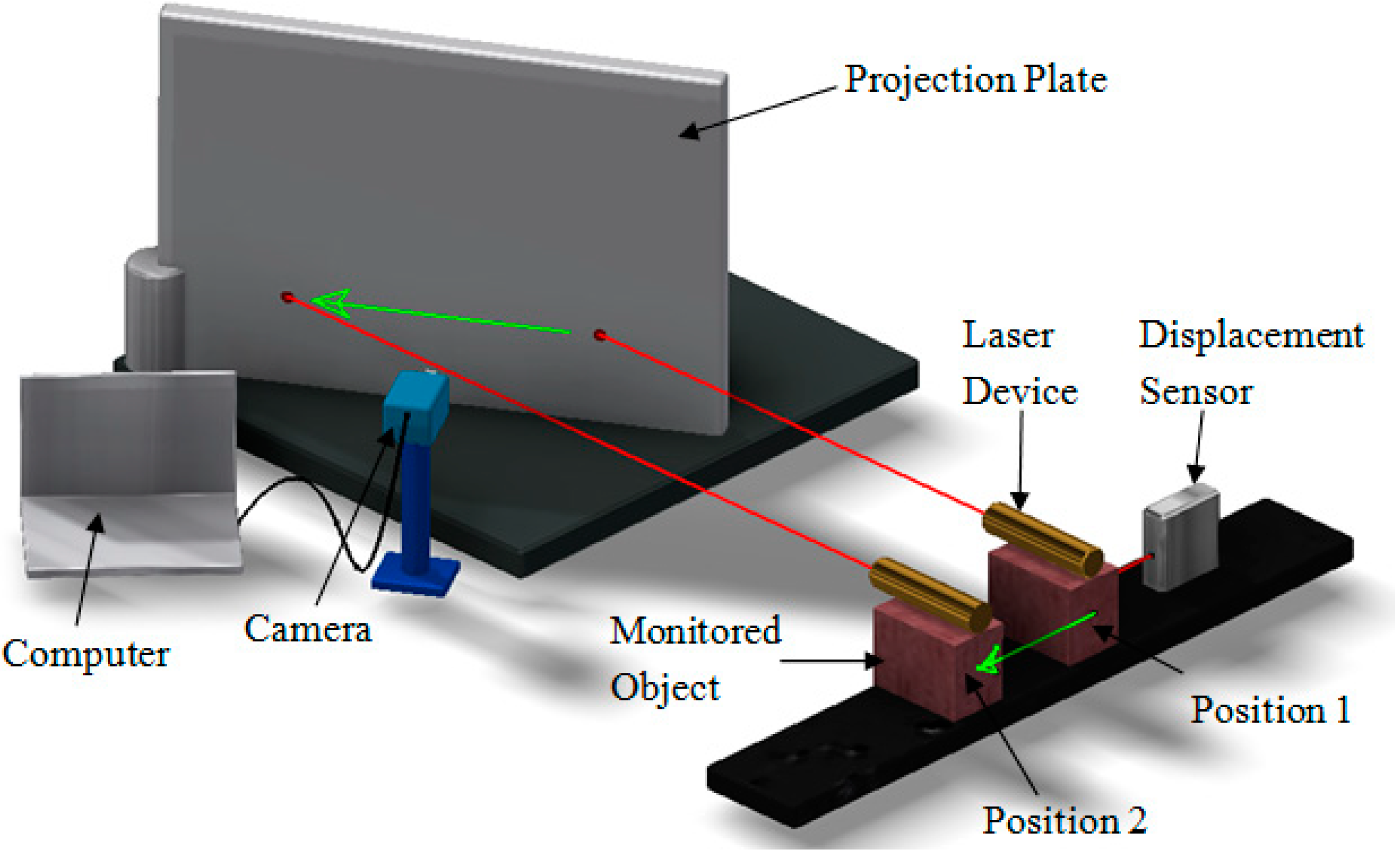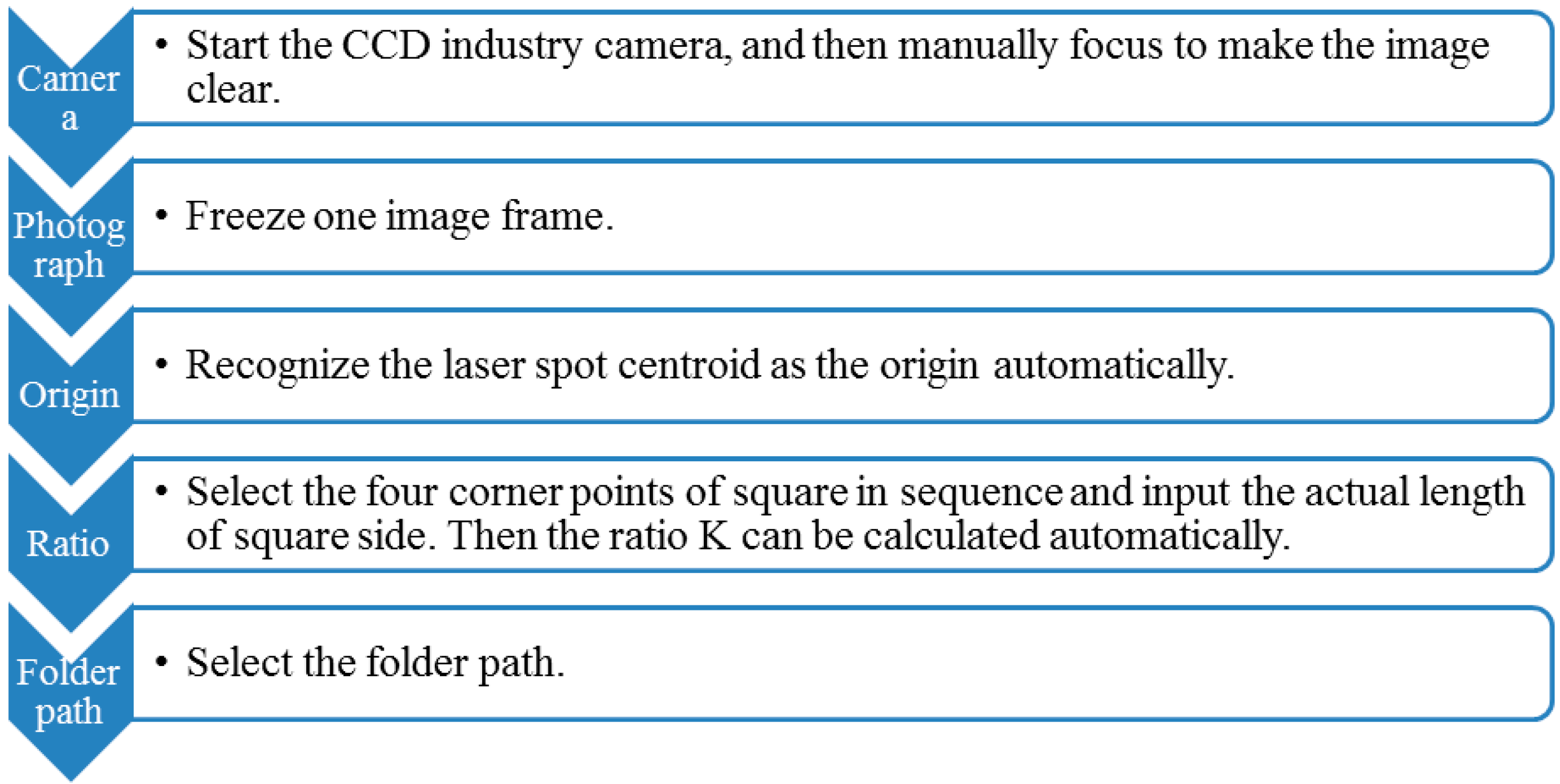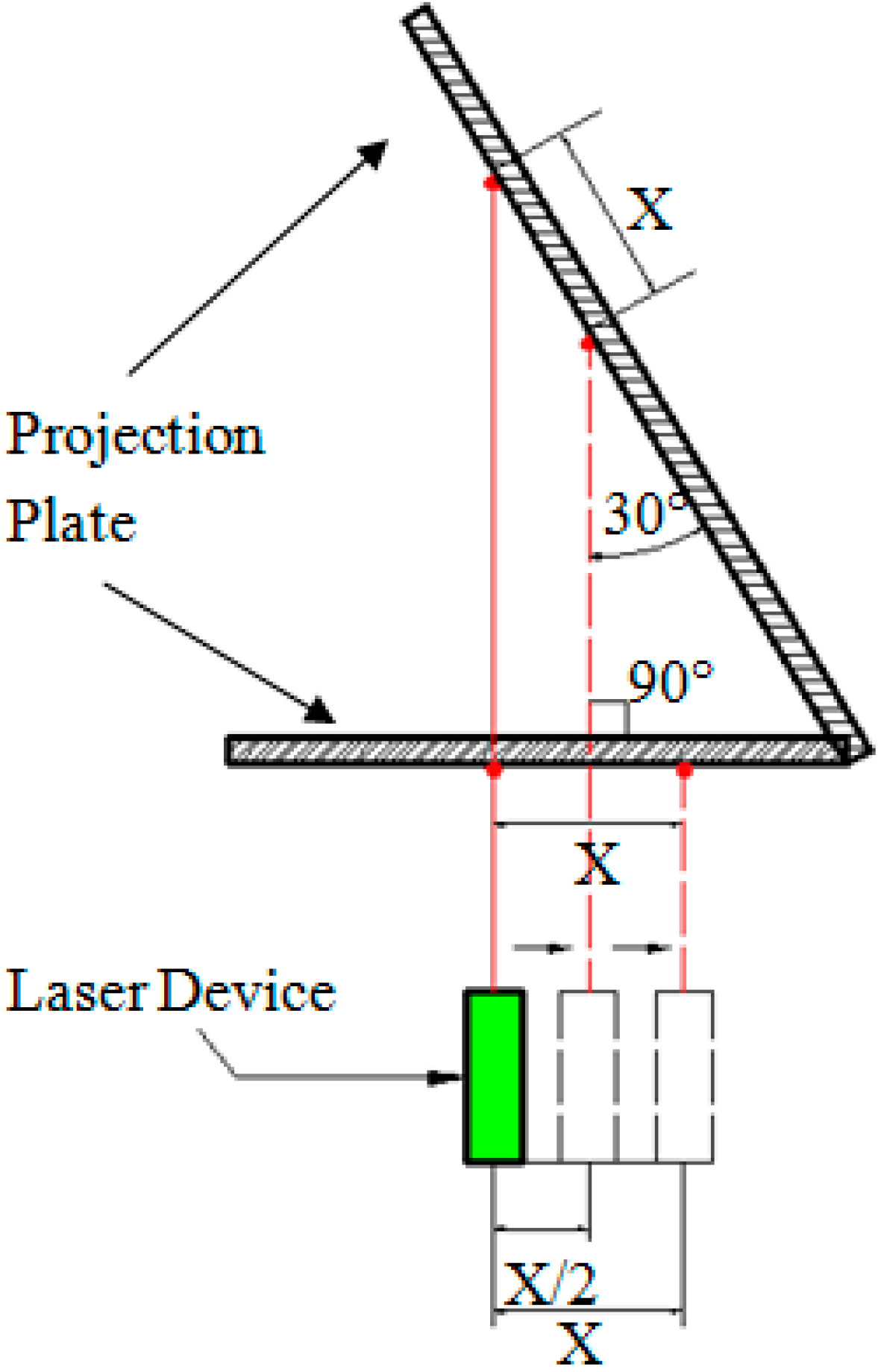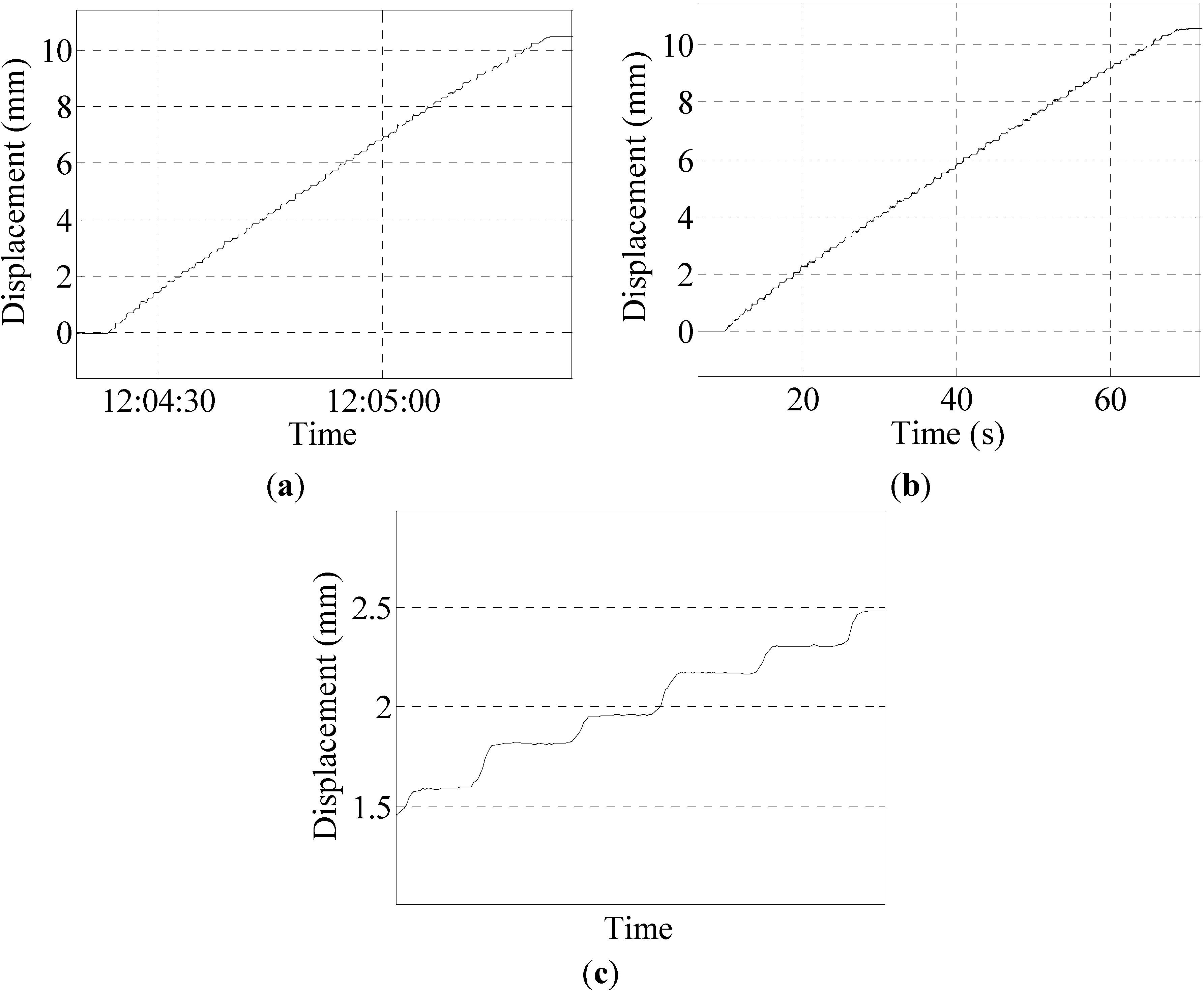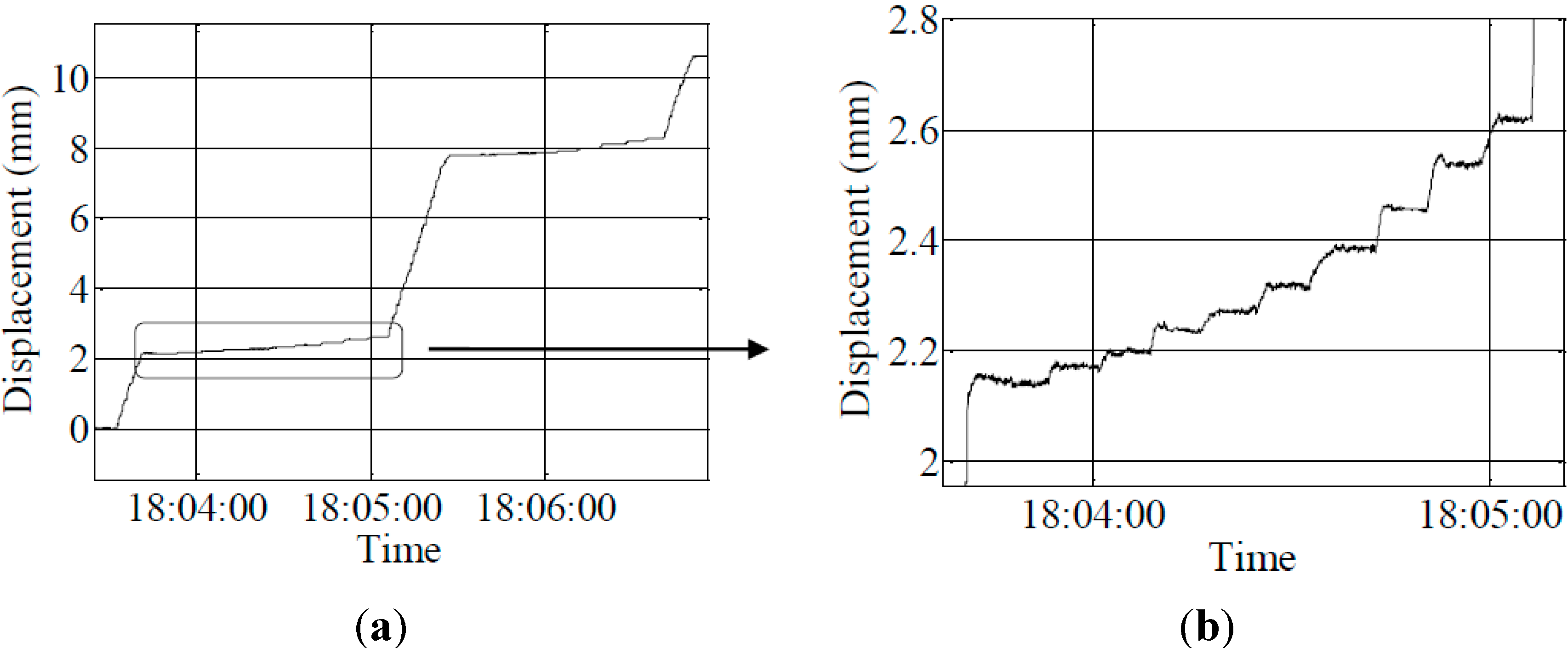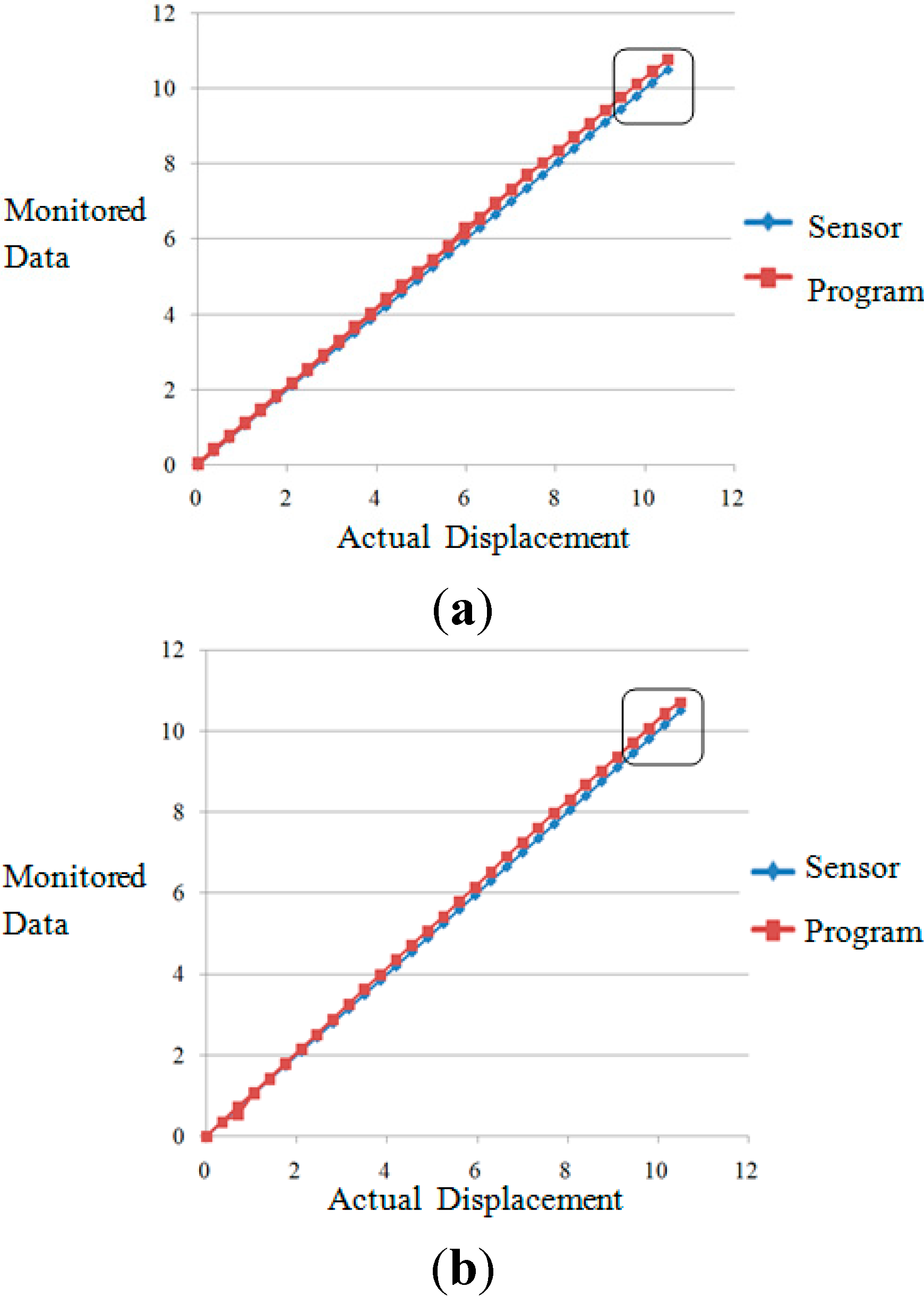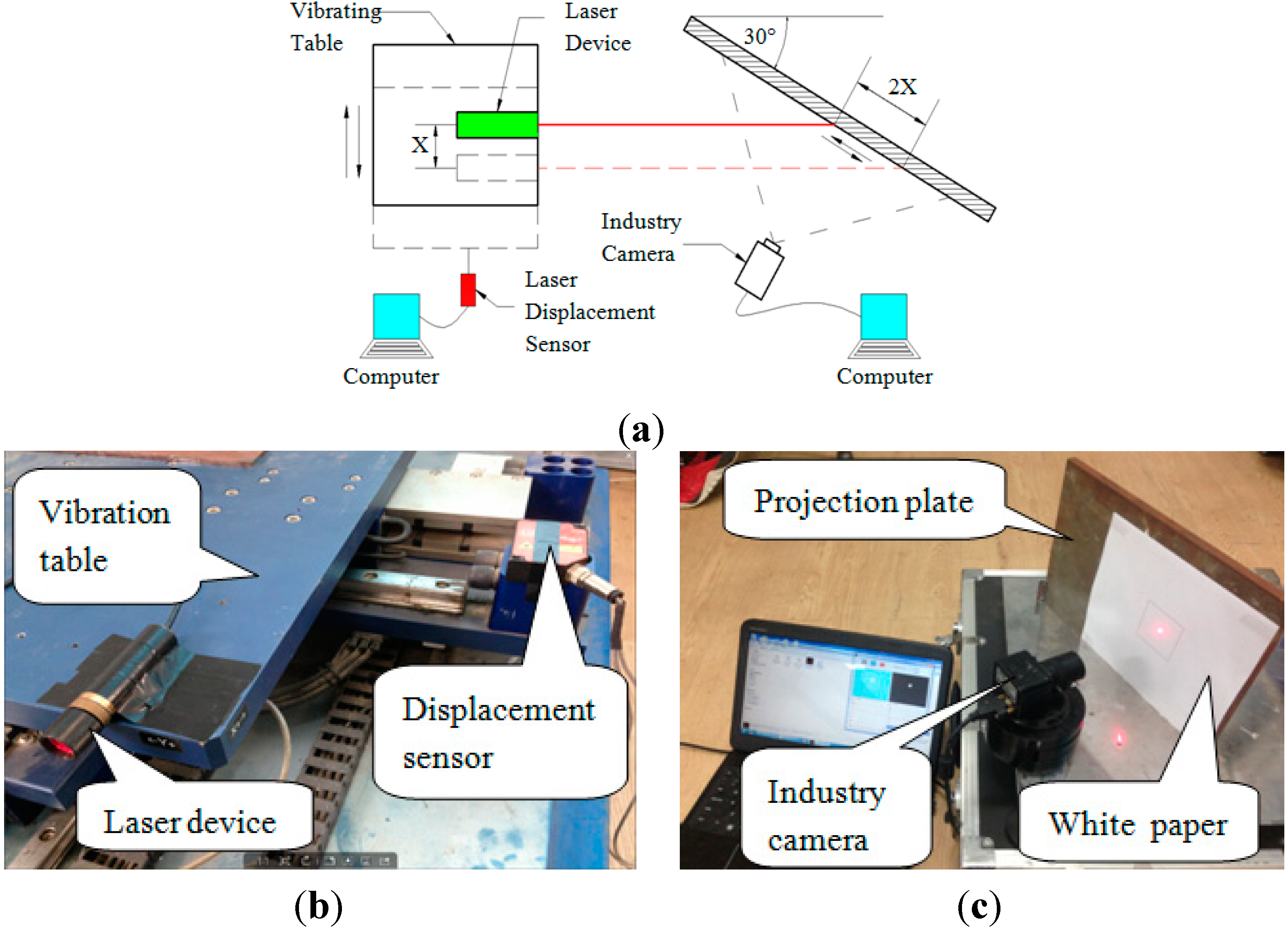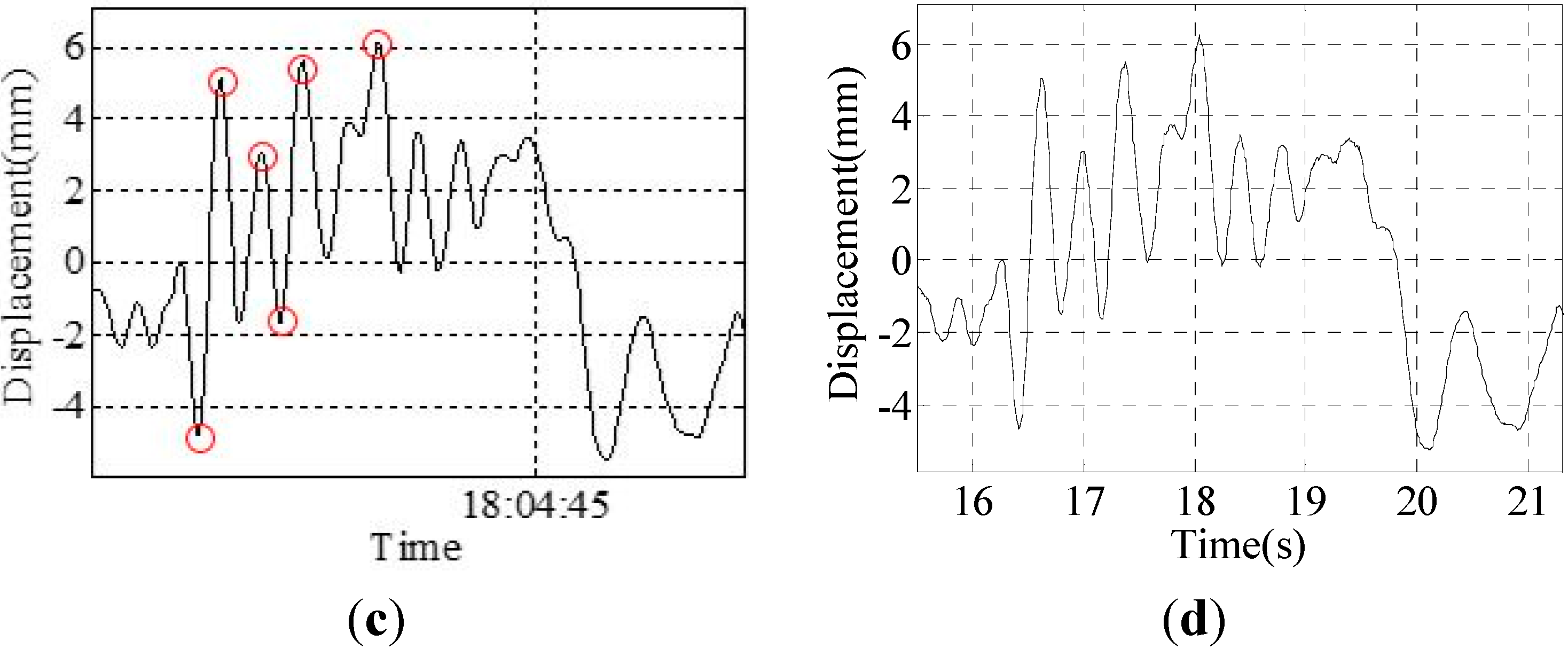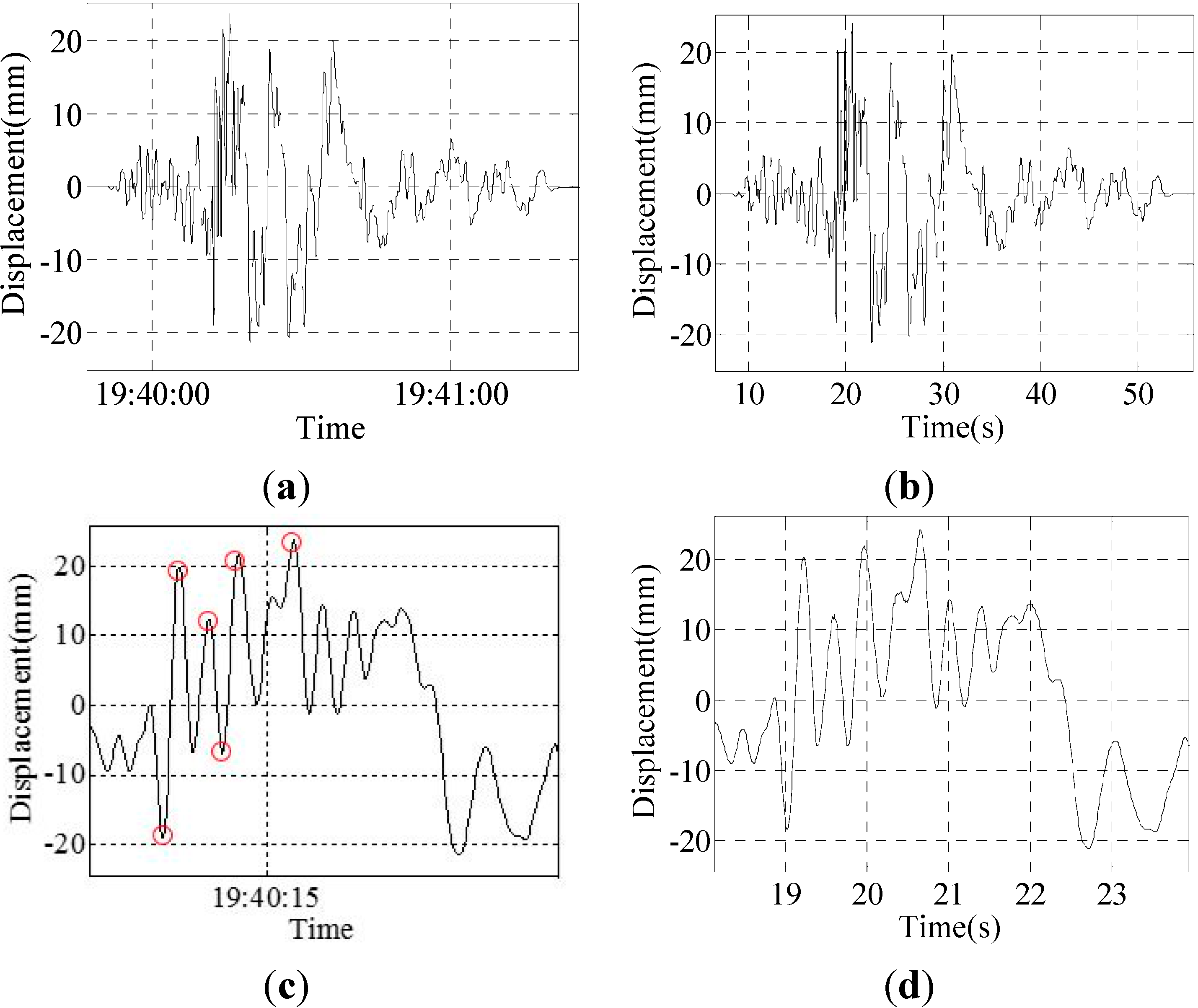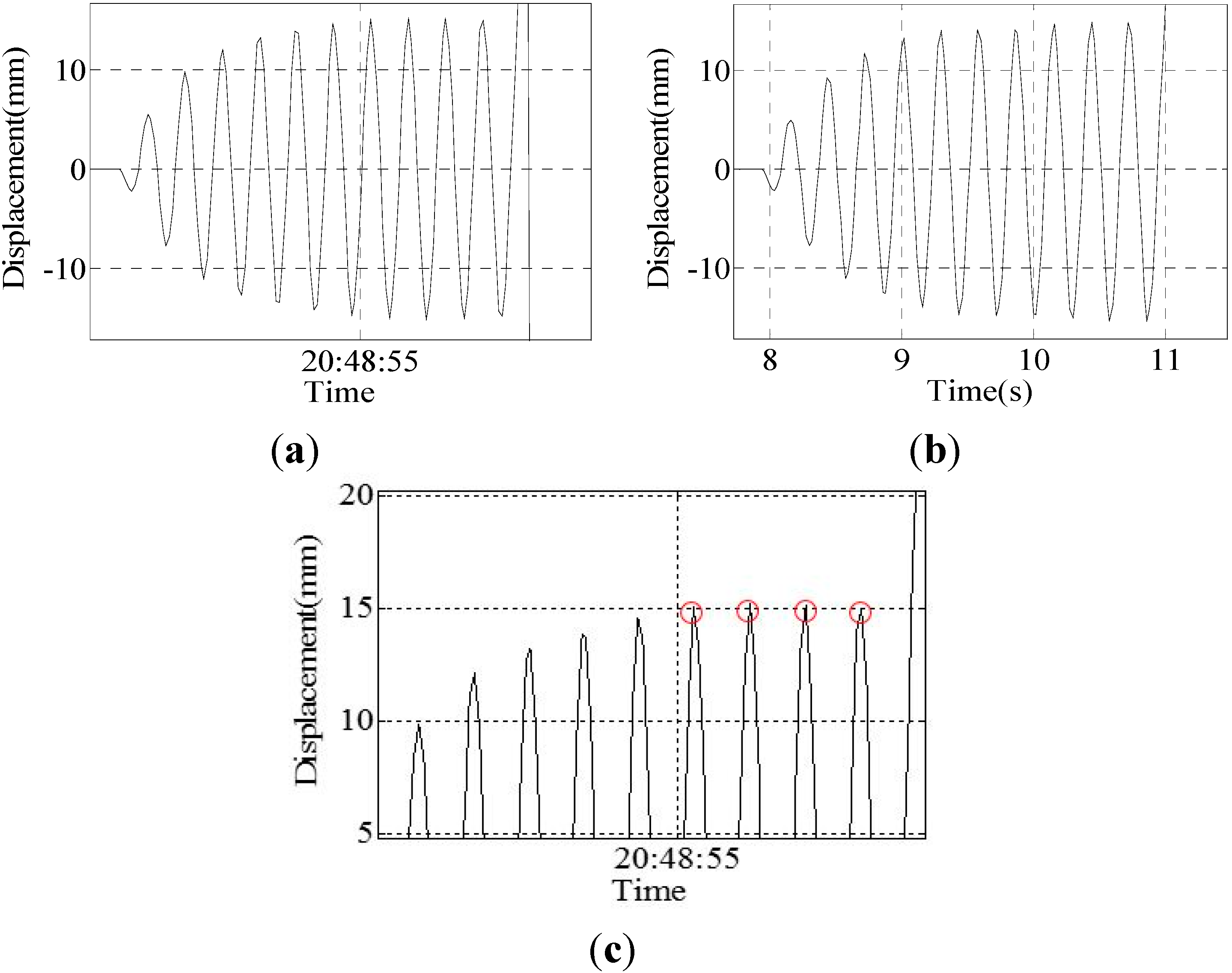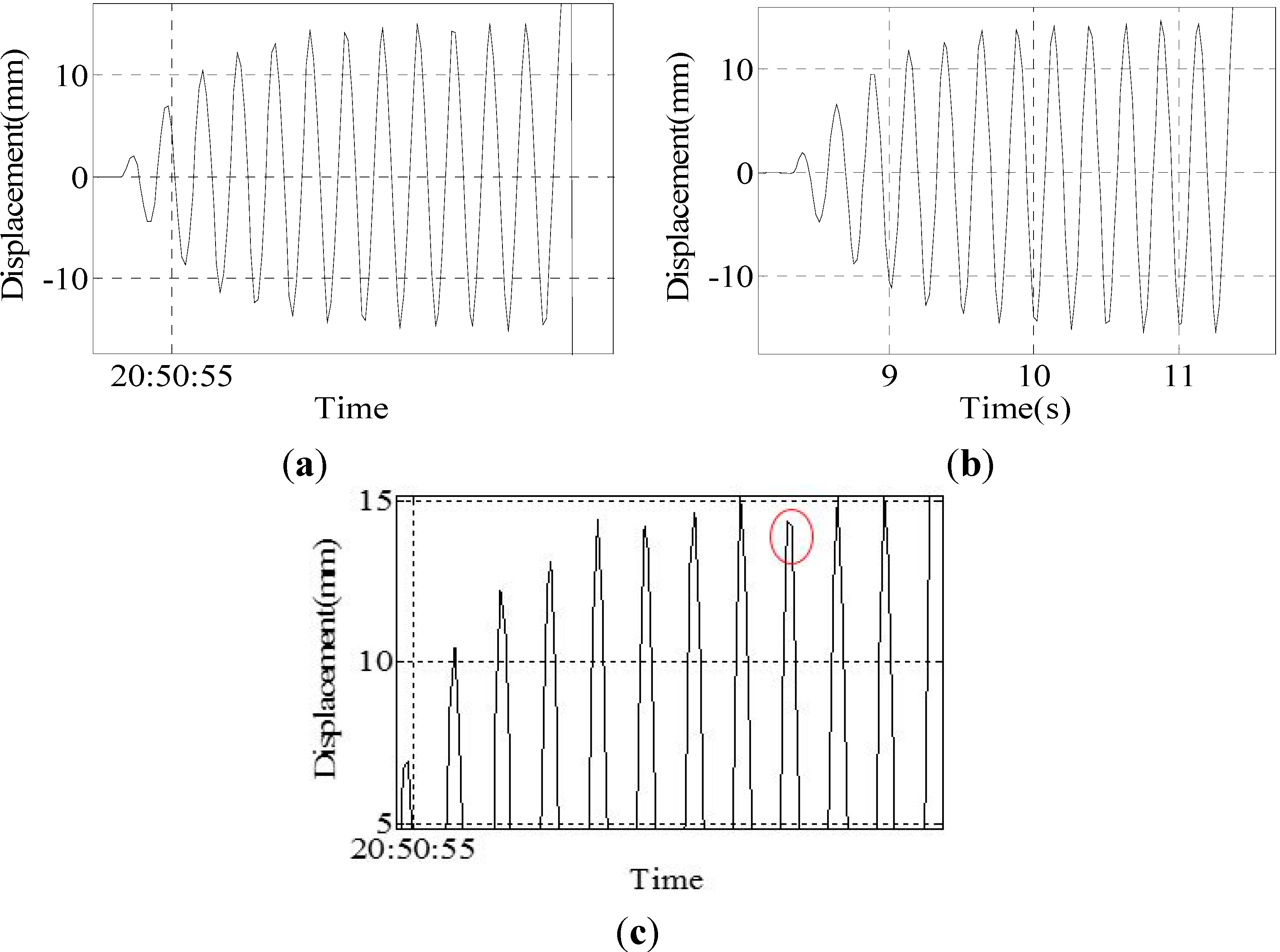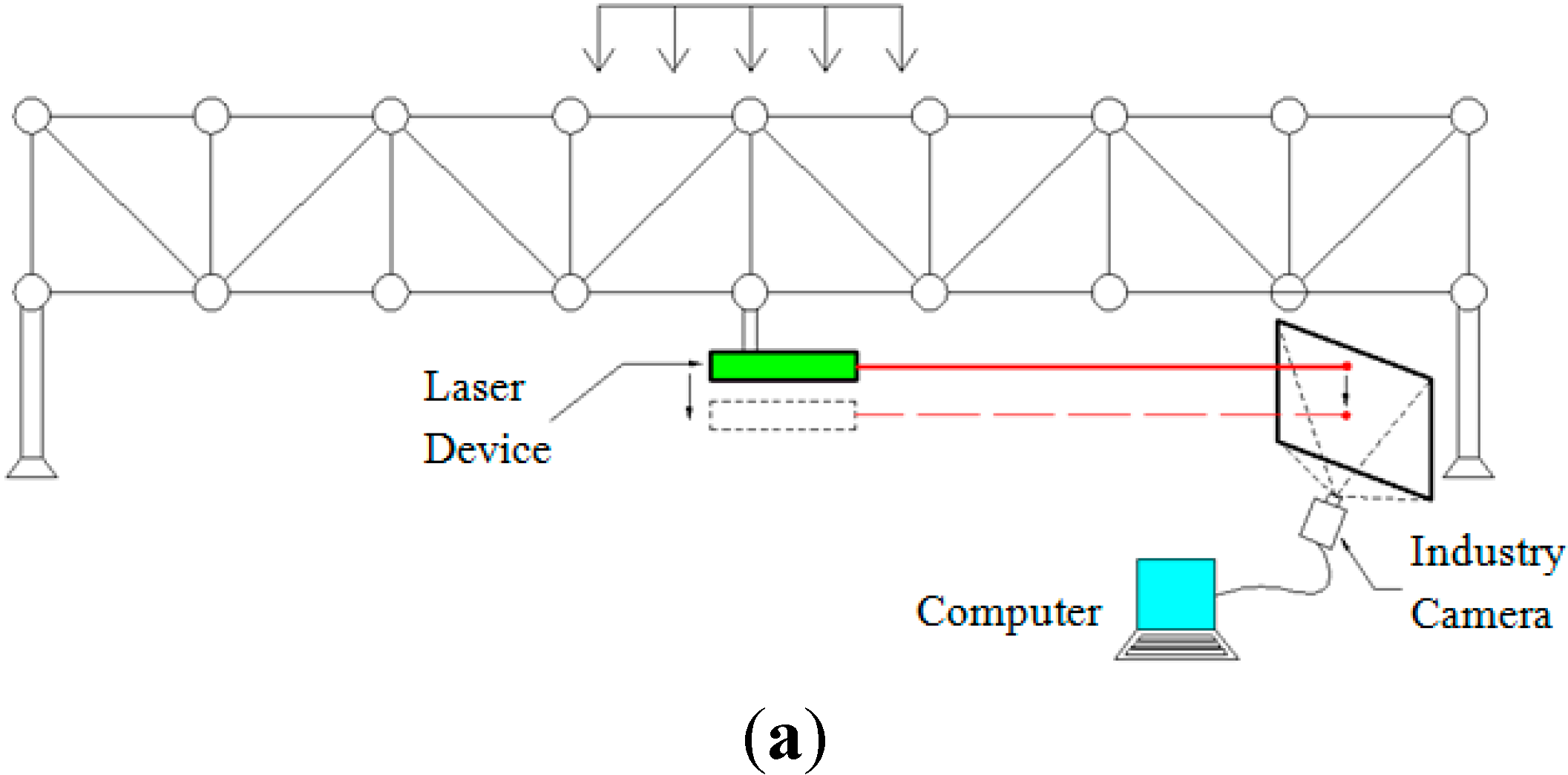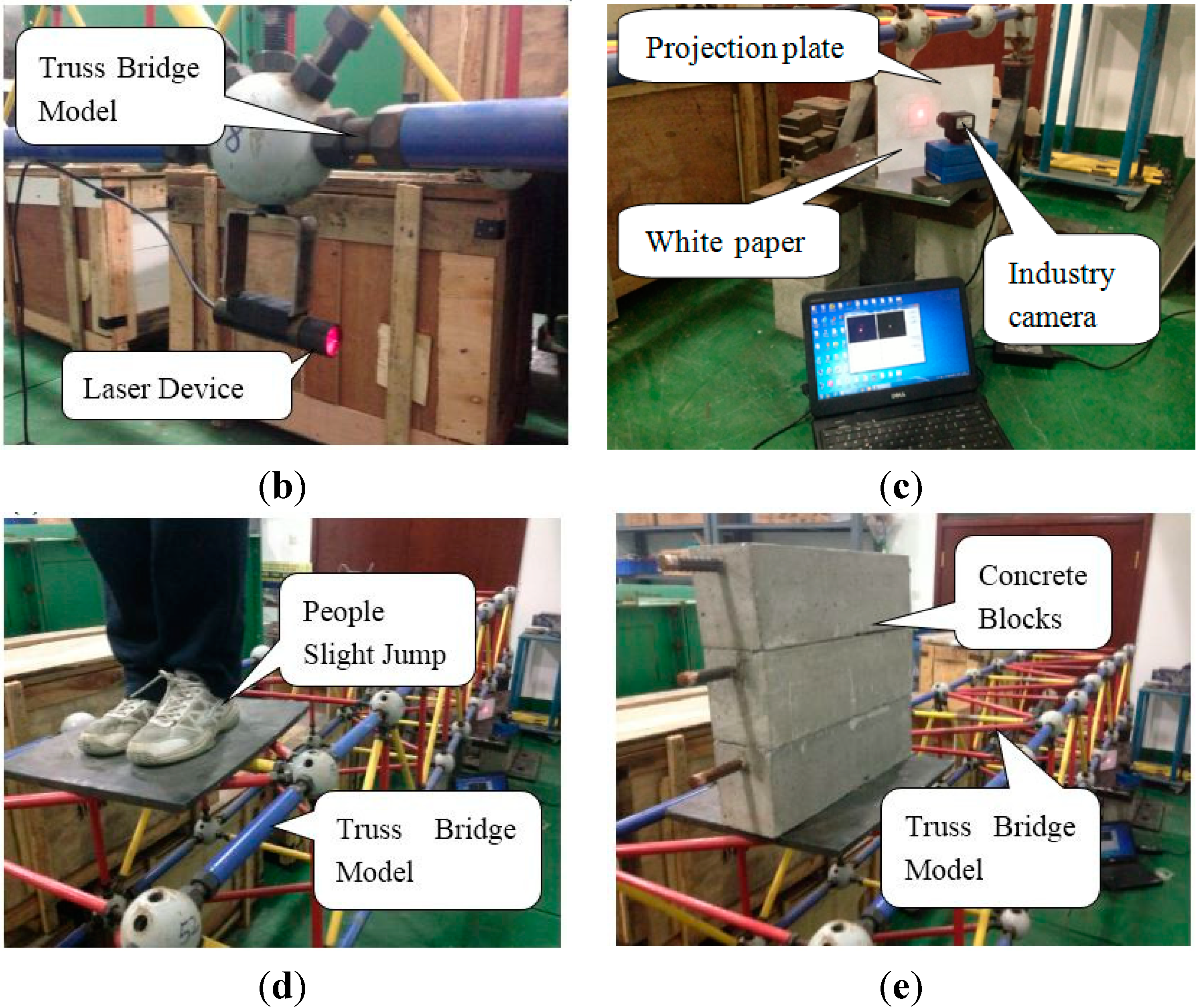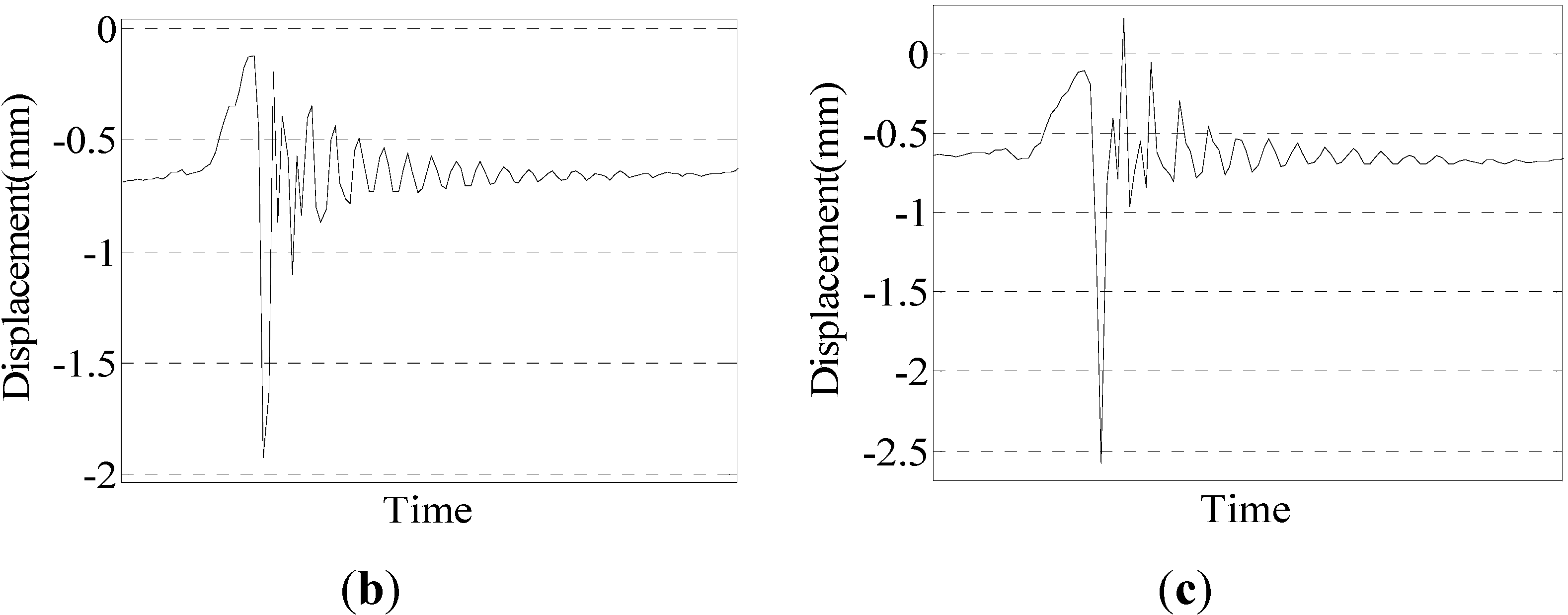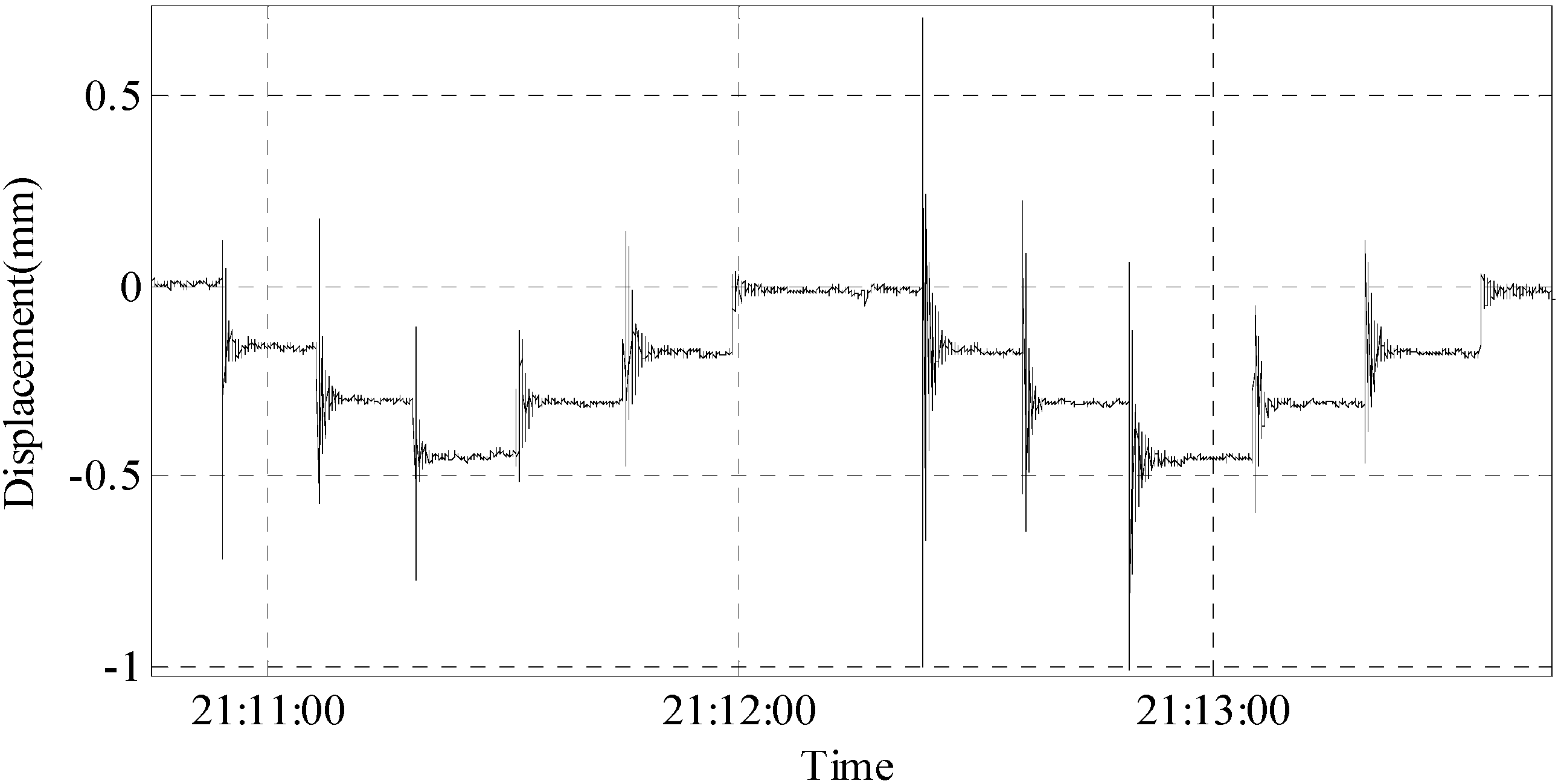1. Introduction
Bridges are an important part of the transportation infrastructure. Structural safety of bridges is not only related to the healthy and orderly development of the social, political, economic, national defense and other various undertakings of a country, but also directly affects the safety of the lives and properties of the people. Bridge displacement is the comprehensive reflection of the health status of a bridge structure and is the most important technical parameter in judging the overall vertical stiffness and bearing capacity of a bridge structure [
1,
2]. Bridge displacement monitoring is used to measure the displacement of each control section, thus providing a basis for the overall evaluation of the carrying capacity, operation status and endurance capability of a bridge structure. This measure can ensure the safe operation of a bridge structure and prolong its service life. By monitoring bridges, the defective fractures can be identified in a timely manner, thus reducing the repair and maintenance costs significantly and preventing the occurrence of bridge collapse and other major accidents [
3,
4,
5].
Structural displacement monitoring can be accomplished by using numerous methods; the often-used methods are reviewed as follows. (1) Displacement sensors and acceleration sensors [
6]: The displacement sensors are easy to use and relatively inexpensive, but in the case that the bridge is high, the displacement sensors cannot be installed under the bridge deck. Acceleration sensors have a negligible effect on structural vibration because of their small size and low weight. However, the identification effect of such sensors is poor for low-frequency static displacement. In addition, double integration is required to obtain the displacement; therefore, the accuracy of acceleration sensors is not high; (2) Laser Doppler vibrometer system [
7]: The laser Doppler vibrometer system as a non-contact, non-destructive method of measuring the vibration and displacement of bridges has been shown to provide accurate results. However, this system is not suitable for long-term bridge monitoring, since it is oftentimes placed on the ground underneath the bridge and cannot be left unattended; (3) GPS satellite-surveying method [
8,
9]: The main advantages of this method are its applicability to all-weather continuous monitoring, as well as automatic completion of monitoring, recording and calculation. This high-technology method also has limitations in large-scale structural monitoring, such as the strict requirement of the antenna placement environment, low measurement rate, high cost and the need for highly skilled professionals; (4) Robotic total station [
10,
11]: This device has the advantages of high precision, automation and can measure the three-dimensional coordinates. This approach has been widely used in engineering displacement monitoring, but it cannot complete multi-target tasks in a short time. Moreover, due to its low measuring frequency, the requirement of dynamic measurement cannot be satisfied; (5) Terrestrial laser scanning [
12,
13]: This method can rapidly build complex, irregular 3D visualization scene models. However, the monitoring accuracy of each sampling point is low, and the post-processing of massive data is complicated; (6) Strain sensors: This method can draw the exact vertical displacement of a bridge, which, uniformly loaded on
n + 1 supports with the use of 6 ×
n strain sensors, can also measure the deformation of the frame, and so on. However, it is unsuitable for measuring the mid-span deformation of long-span bridges [
2,
14].
In summary, the current use of a relatively wide range of monitoring methods for engineering structures may have some limitations that hinder the realization of the long-term and real-time dynamic monitoring for bridge displacement. In recent years, laser projection-sensing technology, the core technique of which is digital video processing, has been studied for object displacement monitoring. The above-mentioned monitoring method has many advantages [
4]:
- (1)
High precision and low cost.
- (2)
High image acquisition frequency and able to reflect the variation of structural dynamic displacement completely.
- (3)
High image processing efficiency and able to meet the requirement of real-time collection, real-time processing and displacement curve real-time display.
- (4)
Meets the requirement of scalability analysis for the collected data.
- (5)
Easy to carry out technology upgrading; the digital form and transmission method of video can be easily combined with the existing digital communication and computer technology to provide people with new, more flexible, more convenient services.
Considerable research progress and several achievements have been attained by this technology in different fields.
In 2009, Zhang
et al. [
15,
16] of China studied the laser projection-sensing technology and designed a practical bridge displacement monitoring experiment at He’ergou Bridge. Data were automatically collected 20 min/time, and the monitoring results were compared with the data of the water-level deflection instrument. The experiment showed that the laser projection method operated better and was more accurate than the water-level deflection instrument, especially for high-fall and long-span bridges. This experiment was followed by a study of the anti-interference capability and high precision laser spot location algorithm.
In 2010, Kanekawa and Matsuya,
et al. [
17] from Japan formed a relative-story displacement sensor with a laser device and a phototransistor (PT) array. When moved with the floor, the laser device projected the laser spot onto the PT array, and the relative displacement between the ceiling and the floor was estimated by the distribution of the PT output voltage. The accuracy of the measurements was 0.11 mm, with a dynamic range of 70 mm and with a sampling rate of 200 Hz.
In 2010, Myung
et al. [
18] from Korea proposed a visually-servoed paired structured light system, which was composed of two sides facing each other, each with a camera, a screen and one or two lasers controlled by a 2-DOF manipulator. In this system, the relative translational and rotational displacement between two sides can be estimated by calculating the positions of the projected laser beams on the screens and the rotation angles of the manipulators.
In 2011, Jeon
et al. [
19] studied a paired visual servoing system for 6-DOF displacement measurement of structures. In this study, a calibration method was proposed to offset the initial displacement using the first captured image, and a newly designed 2-DOF manipulator for each side was visually controlled to prevent the laser beams from leaving the screen.
In 2013, Thomas and Ali [
20] proposed a methodology for a virtual visual sensor (VVS) to measure structural vibrations. The fundamental frequency of vibration of single-degree-of-freedom (SDOF) systems can be accurately computed using the proposed methodology of VVS, and multiple independently vibrating elements in one video can be distinguished and their fundamental frequency of vibration computed.
From the foregoing text, the object displacement monitoring method based on laser projection-sensing technology has gradually received considerable attention and has become widely used. Based on digital image processing techniques, the displacement monitoring software was developed to provide a real-time display of the two-dimensional coordinate values and the coordinate change curve of the laser spot. The hardware adopts commercially available optoelectronic devices and optical devices, which can be conveniently assembled, are low cost and are conducive to hardware equipment upgrading and expansion to a higher performance level. The experimental results show that this system is feasible for static and dynamic displacement monitoring.
3. Experiments and Results
A series of static and dynamic displacement monitoring experiments have been conducted to prove the feasibility of the proposed program. The static displacement monitoring experiments aim to verify the stability of the proposed program. The dynamic displacement monitoring experiments are mainly used to observe whether the motion trail is successfully reflected when the monitored objected is moving quickly.
3.1. Main Instruments Parameters
The main instrument parameters are shown in
Table 1.
Table 1.
Main instrument parameters.
Table 1.
Main instrument parameters.
| Instrument | Brand | Model | Parameter |
|---|
| Laser Device | Ruic | Red-light semiconductor laser | Output wavelength: 650 nm
Overall dimensions: Φ 20 mm × 90 mm,
Light spot diameter is 3 mm at a 20-m distance |
| Industrial Camera | Easyxin | Exin-U36 | Resolution: 752 × 480
Frame rate: 40 |
| Camera Lens | Easyxin | YX-0358 | Focal length: 3.5 mm to 8 mm manual zoom |
| Laser Displacement Sensor | MICRO-EPSILON | ILD1300 | Measuring range: 50 mm to 150 mm
Resolution (dynamic): 100 microns |
3.2. Static Experiment
The instruments used are the displacement loading device, laser device, industrial camera, white paper, projection plate, laptop computer and laser displacement sensor.
3.2.1. Process of Static Experiment
The laser device is mounted onto the pedestal of the displacement loading device. The knob of the pedestal is rotated to enable the pedestal to drive the laser device motion. The laser displacement sensor is adopted to measure the precise displacement of the pedestal. The displacement of the pedestal is 0.35 mm when the knob is rotated one complete lap. The loading process is so slow, that it can be assumed as static. The experimental schematic diagram and field experiment images are shown in
Figure 6.
Figure 6.
(a) Experimental schematic diagram of the static experiment; (b,c) experiment photos of the static experiment.
Figure 6.
(a) Experimental schematic diagram of the static experiment; (b,c) experiment photos of the static experiment.
3.2.2. Results of the Static Experiments
Simple Load Experiment
The knob was continuously rotated for 30 laps, and the total displacement of pedestal is about 10.5 mm. The results are shown in
Figure 7.
Figure 7.
(a) Result of the program in Group 1; (b) result of the sensor in Group 1; (c) partial enlarged detail of the program result.
Figure 7.
(a) Result of the program in Group 1; (b) result of the sensor in Group 1; (c) partial enlarged detail of the program result.
As can be seen from the above figures, the peak datum of the laser displacement sensor is 10.58 mm, whereas that of the program is 10.54 mm. The difference is 0.04 mm, and the error between them is negligible at 0.38%.
Accuracy Testing Experiments
Accuracy testing experiments aim to figure out whether the system can monitor the pedestal displacement change when the pedestal displacement is small. In the process of loading, the pedestal displacement is loaded from 0.01 mm to 0.02 mm, until 0.1 mm. The results are shown in
Figure 8.
As shown in the figures above, when the displacement of the pedestal is 0.02 mm, the system can already reflect the change curve and the amount of change of the pedestal’s displacement. This proves that the system has high sensitivity, and the identification of small displacement is ideal.
Figure 8.
(a) Result of the program in Group 2; (b) partial enlarged detail of the program result.
Figure 8.
(a) Result of the program in Group 2; (b) partial enlarged detail of the program result.
Displacement Loop Experiment
The displacements of the laser spot centroid are manually recorded when the knob is rotated one lap. The total number of the rotations is 30, and the total displacement is approximately 10.5 mm. Loading is continuously applied three times back and forth, thus resulting in a three-loop process. The dotted lines shown in
Figure 9 reflect the displacement of each loop, wherein the horizontal axis represents the displacement of the pedestal and the vertical axis represents the monitored displacement (the blue dotted line represents the data of the laser displacement sensor, whereas the red dotted line represents the data of the program).
Figure 9.
(a) First displacement loop; (b) second displacement loop; (c) third displacement loop.
Figure 9.
(a) First displacement loop; (b) second displacement loop; (c) third displacement loop.
The last four points of each loop were selected, seven data in total, and the data comparison of laser displacement sensor and the program is shown in
Table 2.
Table 2.
Comparison of the data of the sensor and program.
Table 2.
Comparison of the data of the sensor and program.
| Program | 9.760 | 10.110 | 10.455 | 10.765 | 10.455 | 10.110 | 9.755 |
|---|
| Sensor | 9.450 | 9.853 | 10.211 | 10.550 | 10.150 | 9.822 | 9.451 |
| Difference | 0.31 | 0.257 | 0.244 | 0.215 | 0.305 | 0.288 | 0.304 |
| Error | 3.28% | 2.61% | 2.39% | 2.04% | 3.00% | 2.93% | 3.22% |
| Program | 9.715 | 10.065 | 10.425 | 10.715 | 10.405 | 10.05 | 9.695 |
| Sensor | 9.451 | 9.853 | 10.212 | 10.550 | 10.150 | 9.824 | 9.455 |
| Difference | 0.264 | 0.212 | 0.213 | 0.165 | 0.255 | 0.226 | 0.24 |
| Error | 2.79% | 2.15% | 2.09% | 1.56% | 2.51% | 2.30% | 2.54% |
| Program | 9.610 | 9.960 | 10.335 | 10.620 | 10.275 | 9.93 | 9.585 |
| Sensor | 9.451 | 9.855 | 10.211 | 10.552 | 10.150 | 9.818 | 9.453 |
| Difference | 0.159 | 0.105 | 0.124 | 0.068 | 0.125 | 0.112 | 0.132 |
| Error | 1.68% | 1.07% | 1.21% | 0.64% | 1.23% | 1.14% | 1.40% |
As shown in the figures above, the stability of the data of the program is very good; both are synthesized into a straight line, and the difference with the data of the laser displacement sensor is very small. The table above shows that the data error between the program and the laser displacement sensor is within 3.28%.
3.3. Dynamic Experiment of the Vibration Table
The instruments used are a vibration table, a laser device, an industrial camera, A4 paper, a projection plate, a laptop computer and a laser displacement sensor.
3.3.1. Experiment Arrangement
The laser device is mounted on the vibration table and moves along with the vibration table. The laser displacement sensor is adopted to monitor the precise displacement of the vibration table.
A series of dynamic experiments were performed, including experiments of three different seismic waves, each applied with three different incentives (0.2, 0.5 and 0.8), and experiments of sine waves of different amplitudes, namely, 10, 15 and 20 mm, each sine wave having a frequency change from 0.5 Hz, 1.0 Hz, 1.5 Hz to 5.0 Hz. The experimental schematic and images of the field experiments are shown in
Figure 10.
Figure 10.
(a) Experimental schematic of the dynamic experiment; (b,c) field experiment of the dynamic experiment.
Figure 10.
(a) Experimental schematic of the dynamic experiment; (b,c) field experiment of the dynamic experiment.
3.3.2. Experiment Results of the Vibration Table
The graphs show the results of the Japan Kobe earthquake wave; the incentive waves were 0.2 and 0.8, and for the results of the sine wave of 15-mm amplitude, the frequencies were 3.0 Hz, 3.5 Hz and 4.0 Hz.
Group I: The Japan Kobe earthquake of a 0.2 incentive wave and maximum displacement of about 6.2 mm; the results are shown in
Figure 11.
Figure 11.
Results of Group 1: (a) result of the program; (b) result of the sensor; (c) partial enlarged detail of the result of the program; (d) partial enlarged detail of the result of the sensor.
Figure 11.
Results of Group 1: (a) result of the program; (b) result of the sensor; (c) partial enlarged detail of the result of the program; (d) partial enlarged detail of the result of the sensor.
Six peak point displacement values are selected to compare, and the results are shown in
Table 3.
Table 3.
Data comparison of the sensor and program.
Table 3.
Data comparison of the sensor and program.
| Program | −4.853 | 5.142 | 3.086 | −1.668 | 5.636 | 6.199 |
|---|
| Sensor | −4.685 | 5.067 | 3.022 | −1.648 | 5.517 | 6.242 |
| Difference | 0.168 | 0.075 | 0.064 | 0.02 | 0.119 | 0.043 |
| Error | 3.58% | 1.48% | 2.11% | 1.21% | 2.16% | 0.69% |
Group II: The Japan Kobe earthquake of a 0.8 incentive wave and maximum displacement of approximately 24 mm; the results are shown in
Figure 12.
Figure 12.
Results of Group 2: (a) result of the program; (b) result of the sensor; (c) partial enlarged detail of the result of the program; (d) partial enlarged detail of the result of the sensor.
Figure 12.
Results of Group 2: (a) result of the program; (b) result of the sensor; (c) partial enlarged detail of the result of the program; (d) partial enlarged detail of the result of the sensor.
Six peak point displacement values are selected to compare, and the results are shown in
Table 4.
Table 4.
Data comparison of the sensor and program.
Table 4.
Data comparison of the sensor and program.
| Program | −19.000 | 19.970 | 12.39 | −6.813 | 21.71 | 23.74 |
|---|
| Sensor | −18.42 | 20.36 | 12.18 | −6.53 | 21.94 | 24.09 |
| Difference | 0.58 | 0.39 | 0.19 | 0.283 | 0.23 | 0.35 |
| Error | 3.15% | 1.91% | 1.56% | 4.33% | 1.05% | 1.45% |
The experimental results show that when the random vibration of the vibration table occurs, the data differences between the program and laser displacement sensor are very small; the error is within 4.33%. The displacement change of the vibration table can be accurately and completely monitored by this system.
Group III: The experimental results of the sine wave of a 3.0-Hz frequency and 15-mm amplitude are shown in
Figure 13.
Figure 13.
Results of Group 3: (a) result of the program; (b) result of the sensor; (c) peak curve of the result of the program.
Figure 13.
Results of Group 3: (a) result of the program; (b) result of the sensor; (c) peak curve of the result of the program.
Four peak point displacement values are selected to compare, and the results are shown in
Table 5.
Table 5.
Data comparison of the sensor and program.
Table 5.
Data comparison of the sensor and program.
| Program | 14.95 | 15.01 | 14.88 | 15.10 |
|---|
| Sensor | 13.96 | 14.46 | 14.23 | 14.63 |
| Difference | 0.99 | 0.55 | 0.65 | 0.47 |
| Error | 7.10% | 3.80% | 4.57% | 3.21% |
Group IV: The experimental results of the sine wave of a 3.5-Hz frequency and 15-mm amplitude are shown in
Figure 14.
Figure 14.
Results of Group 4: (a) result of the program; (b) result of the sensor; (c) peak curve of the result of the program.
Figure 14.
Results of Group 4: (a) result of the program; (b) result of the sensor; (c) peak curve of the result of the program.
Four peak point displacement values are selected to compare, and the results are shown in
Table 6.
Table 6.
Comparison of the data of the sensor and program.
Table 6.
Comparison of the data of the sensor and program.
| Program | 15.03 | 15.20 | 15.12 | 14.96 |
|---|
| Sensor | 14.09 | 14.66 | 14.83 | 14.77 |
| Difference | 0.94 | 0.54 | 0.29 | 0.19 |
| Error | 6.67% | 3.68% | 1.96% | 1.29% |
Group V: The experimental results of the sine wave of a 4.0-Hz frequency and 15-mm amplitude are shown in
Figure 15.
Due to the laser displacement sensor being placed next to the vibration table, the sensor will have a slight vibration caused by the vibration table; therefore, the accuracy of the monitoring will be decreased. It can be seen from
Table 4 and
Table 5 that the data of the laser displacement sensor are not ideal; the range of the peak points’ value is large, ranging between 13.96 and 14.83. However, the peak point data of the program is around 15 mm, ranging between 14.88 and 15.20, so the data of the program are better. The experimental results show that when the vibration frequency of the vibration table is less than or equal to 3.5 Hz, the displacement change of the vibration table can be accurately and completely monitored by this system. However, when the vibration frequency is greater than or equal to 4.0 Hz, some individual peak points of the displacement curve cannot be monitored. This limitation is attributed to the camera frame rate, which is approximately 40 frames per second. If the vibration is too fast, then the camera fails to capture all of the peak points, as shown in
Figure 14c.
Figure 15.
Results of Group 5: (a) result of the program; (b) result of the sensor; (c) peak curve of the result of the program.
Figure 15.
Results of Group 5: (a) result of the program; (b) result of the sensor; (c) peak curve of the result of the program.
3.4. Dynamic Experiment of the Truss Bridge Model
The instruments used are a truss bridge model, a laser device, an industrial camera, A4 paper, a projection plate, a laptop computer and a laser displacement sensor. The model consists of 16-Mn steel, a bolt ball and a bolt. Each lever is 0.4 m long, and the model is 6.4 m long.
3.4.1. Experiment Arrangement
The laser device is mounted on the bottom of the mid-span of the truss bridge model, and the projection plate is placed at one end of the model. The load is then applied to the mid-span of the model by people who are slightly jumping and laying concrete blocks. The experimental schematic and images of the field experiments are shown in
Figure 16.
Figure 16.
(a) Experimental schematic diagram of the static experiment; (b–e) photos of the static experiment.
Figure 16.
(a) Experimental schematic diagram of the static experiment; (b–e) photos of the static experiment.
3.4.2. Experiment Results
Group 1: The results of the experiment involving a 150-pound person slightly jumping in mid-span are shown in
Figure 17.
As shown in the figures above, the maximum displacement is only approximately 2.6 mm, which is very small. However, this system can monitor the attenuation trend of the displacement well, and the monitoring result is ideal.
Group 2: Three concrete blocks, each having a length of 50 cm and a cross-sectional area of 15 cm × 15 cm, are laid in the mid-span. Loading and unloading were repeated twice, and the experimental results are shown in
Figure 18.
Figure 17.
(a) Result of a person slightly jumping; (b) enlarged second vibration curve; (c) enlarged third vibration curve.
Figure 17.
(a) Result of a person slightly jumping; (b) enlarged second vibration curve; (c) enlarged third vibration curve.
Figure 18.
The result of the laying of concrete blocks.
Figure 18.
The result of the laying of concrete blocks.
After each time of loading or unloading of a concrete block, the displacement change and vibration of the model can be clearly detected. The displacement changes are shown in the
Table 7.
Table 7.
Displacement changes of the model.
Table 7.
Displacement changes of the model.
| First Cycle | 0 | −0.1611 | −0.3014 | −0.4448 | −0.3056 | −0.1708 | −0.0097 |
|---|
| Difference (mm) | - | 0.1611 | 0.1403 | 0.1413 | 0.1392 | 0.1348 | 0.1611 |
| Second cycle | −0.0097 | −0.1726 | −0.3072 | −0.4501 | −0.3085 | −0.1749 | −0.0147 |
| Difference (mm) | - | 0.1629 | 0.1346 | 0.1429 | 0.1416 | 0.1336 | 0.1602 |
As shown in
Table 6, after loading the first piece or unloading the last piece of the concrete block, the model displacement is approximately 0.1610 mm. In other cases, the model displacement is approximately 0.1400 mm.
4. Conclusions
Through a series of experiments and the analyses of the experimental data, it can be concluded that the precision of the displacement monitoring system based on the laser projection-sensing technology is ideal. In the static experiments, when the displacement is 10.50 mm, the error is 0.04 mm and the recognition of the minimum distance change is 0.02 mm. The experiments of the vibration table can reflect the variation of displacement completely and accurately. The experiments of the steel girder bridge model can monitor the attenuation trend of displacement well, and the displacement repeatability is likewise very good. These results show that the system has the advantages of a simple structure, high accuracy, low cost, ease of operation and stable performance. The system can be a feasible method to monitor bridge displacement. We believe that in the future, with the use of long-distance laser devices with a higher power and a better collimation, large-span bridges and other large structures’ displacement monitoring can be achieved, and with the use of cameras with a higher number of pixels and a higher frame rate, the monitoring of a wider range of displacements and faster vibration of the monitored objects can be realized.
